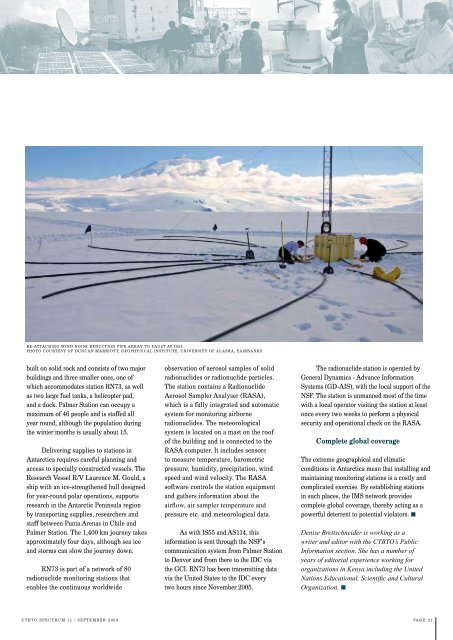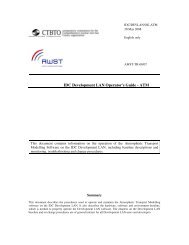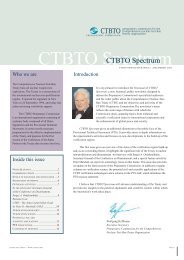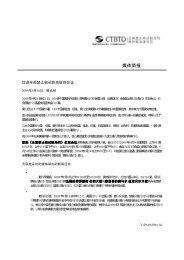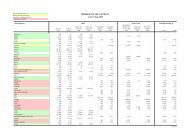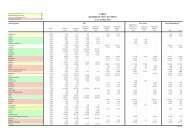ctbto Spectrum
ctbto Spectrum
ctbto Spectrum
You also want an ePaper? Increase the reach of your titles
YUMPU automatically turns print PDFs into web optimized ePapers that Google loves.
Re-attaching wind noise reduction pipe array to vault At IS55.Photo courtesy of Duncan Marriott, Geophysical Institute, University of Alaska, Fairbanks.built on solid rock and consists of two majorbuildings and three smaller ones, one ofwhich accommodates station RN73, as wellas two large fuel tanks, a helicopter pad,and a dock. Palmer Station can occupy amaximum of 46 people and is staffed allyear round, although the population duringthe winter months is usually about 15.Delivering supplies to stations inAntarctica requires careful planning andaccess to specially constructed vessels. TheResearch Vessel R/V Laurence M. Gould, aship with an ice-strengthened hull designedfor year-round polar operations, supportsresearch in the Antarctic Peninsula regionby transporting supplies, researchers andstaff between Punta Arenas in Chile andPalmer Station. The 1,400 km journey takesapproximately four days, although sea iceand storms can slow the journey down.RN73 is part of a network of 80radionuclide monitoring stations thatenables the continuous worldwideobservation of aerosol samples of solidradionuclides or radionuclide particles.The station contains a RadionuclideAerosol Sampler Analyser (RASA),which is a fully integrated and automaticsystem for monitoring airborneradionuclides. The meteorologicalsystem is located on a mast on the roofof the building and is connected to theRASA computer. It includes sensorsto measure temperature, barometricpressure, humidity, precipitation, windspeed and wind velocity. The RASAsoftware controls the station equipmentand gathers information about theairflow, air sampler temperature andpressure etc. and meteorological data.As with IS55 and AS114, thisinformation is sent through the NSF’scommunication system from Palmer Stationto Denver and from there to the IDC viathe GCI. RN73 has been transmitting datavia the United States to the IDC everytwo hours since November 2005.The radionuclide station is operated byGeneral Dynamics - Advance InformationSystems (GD-AIS), with the local support of theNSF. The station is unmanned most of the timewith a local operator visiting the station at leastonce every two weeks to perform a physicalsecurity and operational check on the RASA.Complete global coverageThe extreme geographical and climaticconditions in Antarctica mean that installing andmaintaining monitoring stations is a costly andcomplicated exercise. By establishing stationsin such places, the IMS network providescomplete global coverage, thereby acting as apowerful deterrent to potential violators. ■Denise Brettschneider is working as awriter and editor with the CTBTO’s PublicInformation section. She has a number ofyears of editorial experience working fororganizations in Kenya including the UnitedNations Educational, Scientific and CulturalOrganization. ■C T B T O S p e c t r u m 1 1 | S e p t e m b e r 2 0 0 8Pa g e 2 1


